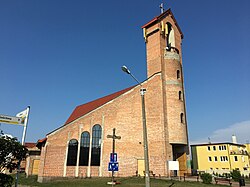Chłapowo, Pomeranian Voivodeship
Chłapowo | |
|---|---|
Village | |
 Local Catholic church | |
 Chłapowo | |
| Coordinates: 54°42′55.4″N 18°37′59.1″E / 54.715389°N 18.633083°ECoordinates: 54°42′55.4″N 18°37′59.1″E / 54.715389°N 18.633083°E | |
| Country | |
| Voivodeship | Pomeranian |
| County | Puck |
| Gmina | Jastarnia (urban gmina) |
| Population | 1,264 |
| Time zone | UTC+1 (CET) |
| • Summer (DST) | UTC+2 (CEST) |
| Vehicle registration | GPU |
Chłapowo (Kashubian: Chłapòwò, German: Chlapau, 1942-45: Klappau) is a Kashubian village in the administrative district of Gmina Jastarnia, within Puck County, Pomeranian Voivodeship, in northern Poland. It lies north-west of Jastarnia, approximately 10 km (6 mi) north of Puck, and 50 km (31 mi) north-west of the regional capital Gdańsk. It is located on the Hel Peninsula on the Baltic Sea.[1] Prior to January 1, 2015 it was a part of the town Jastarnia.
The village has a population of 1069.
History[]
The first mention of Chłapowo comes from 1359, the name of the village was then written in German as Klappow. Chłapowo was a royal village of the Polish Crown, administratively located in the Puck County in the Pomeranian Voivodeship.[2] The name Chłapowo was finally established in the mid-17th century. In the years 1877–1949, 124 box graves of the East Pomeranian culture from the Iron Age (650-400 BC) were discovered and examined in Chłapowo. Archaeologists found well-preserved amber ornaments, ashtrays, glass beads, earthenware, and jewelry. The subsequent archaeological research conducted in the vicinity of the village in the 20th century led to the discovery of traces of settlement from the Neolithic period (4200–1700 BCE) and the Bronze Age (2000–1000 BCE).
The development of Chłapowo began at the end of the 18th century. Rural cottages with thatched roofs and a historic brick chapel have survived to this day. In the mid-nineteenth century, a small lignite mine was operating here. The proximity of the Baltic Sea and the scenery of the Chłapowo Ravine made Chłapowo a summer resort in the interwar period.[citation needed] Summer vacationers (mainly from Warsaw) rented rooms from the peasants who lived in the village. Later, as a result of competition with other resorts (Władysławowo, Jastrzębia Góra, Karwia, Hel Peninsula), Chłapowo lost its importance, preserving the atmosphere of a fishing village.[citation needed] In the vicinity of the village, there are documented deposits of rock salt and potassium-magnesium salt.
Augustyn Necel, the Kashubian writer Augustyn Necel, was born, lived and worked in Chłapowo, creating such works as: Bloody Storm, Kutra with Red Sails, Saga o Swedish Chëczy and Maszopi.
During the German occupation of Poland (World War II), in 1942, several Polish families were expelled by the Germans, and enslaved as forced labour in the county.[3]
Tourism[]
In Chłapowo at al. Żeromskiego, two summer seaside resorts were organized [6].
Along the northern border of Chłapowo there is a sandy beach with a cliff. The main bathing area is situated on the sandy beach.
Chłapowo's attraction is the Chłapowski Gorge, called by the Kashubs Rudnik. It was created as a result of the erosive activity of waters flowing from Wysoczyzna to the Baltic Sea. The shore of a high and steep cliff is constantly washed away by sea waves.
The seaside part of Chłapowo includes the Seaside Landscape Park. This area, remaining beyond human interference, constitutes a fully natural environment. The species found here include broom broom (Cytisus scopartius). There is also Chłapowo Cliff.
References[]
- ^ Rozporządzenie Rady Ministrów z dnia 29 lipca 2014 r. w sprawie połączenia gmin, ustalenia granic niektórych gmin i miast, nadania niektórym miejscowościom statusu miasta oraz zmiany siedziby władz gminy, Dz. U. z 2016 r. poz. 1264 (2014-07-29)
- ^ Marian Biskup, Andrzej Tomczak, Mapy województwa pomorskiego w drugiej połowie XVI w., Toruń, 1955, p. 100 (in Polish)
- ^ Maria Wardzyńska, Wysiedlenia ludności polskiej z okupowanych ziem polskich włączonych do III Rzeszy w latach 1939-1945, IPN, Warszawa, 2017, p. 119 (in Polish)
- Villages in Puck County
- Puck County geography stubs



